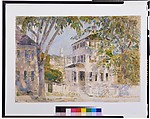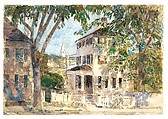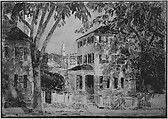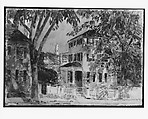Street in Portsmouth
Childe Hassam American
Not on view
Hassam considered the classic white-frame church to be an essential element of the ideal New England community. He presented such a revered icon in his Church at Gloucester of 1918. Hassam even "restored" a burned church in order to incorporate it into this watercolor, painted during a visit to Portsmouth, New Hampshire, in 1916. The meetinghouse that was actually visible from his vantage point was a Romanesque brick structure with an unadorned pyramidal tower. It had been built just twenty years earlier to replace the first Universalist church on the site, whose white, louvered bell tower closely resembled the structure that commands the distance in Hassam's watercolor.
Hassam responded not just to fine Federal churches; even the simplest buildings could inspire him. The three-story clapboard house in this watercolor was built about 1810 near the South Mill Pond. Hassam presented the unpretentious house and its neighbor, with their white picket fences and elm trees framing the distant church and a glimpse of the water, as a microcosm of New England.
Due to rights restrictions, this image cannot be enlarged, viewed at full screen, or downloaded.
This artwork is meant to be viewed from right to left. Scroll left to view more.








